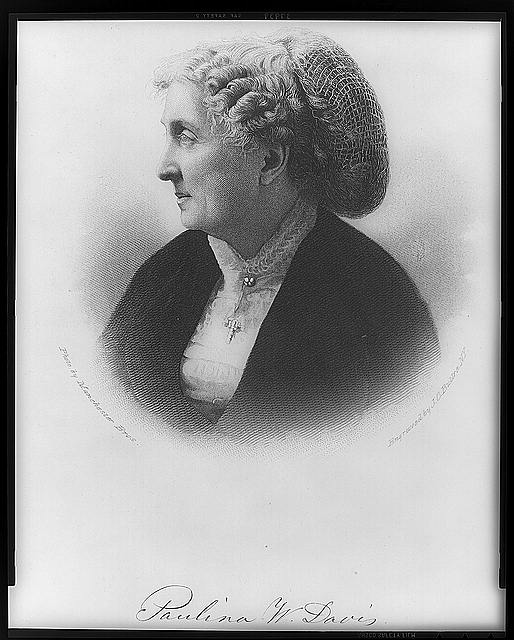Paulina Kellogg Wright Davis
- Paulina Kellogg Wright Davis
Infobox Person
name = Paulina Kellogg Wright Davis

image_size = 250px
caption = Paulina Kellog Wright Davis
birth_date = birth date|1813|8|7|mf=y
birth_place = Bloomfield, New York, U.S.
death_date = death date and age|1876|8|24|1813|8|7
death_place = Providence, Rhode Island, U.S.
occupation = suffragist, abolitionist
spouse =
parents =
children =Paulina Kellogg Wright Davis (August 7, 1813 – August 24, 1876) was an American abolitionist, suffragist, and educator.
Paulina Kellogg was born in Bloomfield, New York, to Captain Ebenezer Kellogg and Polly Saxton. The family moved to the frontier near Niagara Falls in 1817. Both her parents died, and in 1820 she went to live with her orthodox Presbyterian aunt in Le Roy, New York. She joined the church, although she found it hostile to outspoken women. She wanted to become a missionary but was unable to as the church did not allow single women to become missionaries.
She was courted by suitor Francis Wright, a merchant from a prosperous family from Utica, New York; they married in 1833. They had similar values and both resigned from their church to protest its pro-slavery stance and served on the executive committee of the Central New York Anti-Slavery Society. They also supported women's rights reforms, associating with feminists Susan B. Anthony, Elizabeth Cady Stanton and Ernestine Rose. During this period Paulina Kellogg studied women's health. Francis Wright died in 1845; the couple had no children.
Following her husband's death she moved to New York to study medicine. In 1846 she gave lectures on anatomy and physiology to women only. She imported a medical mannequin and toured the eastern United States teaching women and urging them to become physicians. In 1849 she married Thomas Davis, an Irish-American Democrat from Providence, Rhode Island; they adopted two daughters. In 1850 she started to focus her energies on women's rights. She stopped lecturing and helped to arrange the 1850 National Women's Rights convention. In 1853 she began editing the women's newspaper "The Una", which she edited till 1855 when she handed it over to Caroline Henry Dall.
In 1870 she arranged the twentieth anniversary of the Women's Suffrage Movement meeting, and published the proceeds as "The History of the National Woman's Rights Movement".
References
*Lederman, S. H. Davis, Paulina Kellogg Wright. "American National Biography Online" Feb. 2000.
Wikimedia Foundation.
2010.
Look at other dictionaries:
Davis, Paulina Kellogg Wright — ▪ American reformer née Paula Kellogg born Aug. 7, 1813, Bloomfield, N.Y., U.S. died Aug. 24, 1876, Providence, R.I. American feminist and social reformer, active in the early struggle for woman suffrage and the founder of an early periodical… … Universalium
List of people with surname Davis — Davis is a common English language surname shared by many notable people, among them being: A * Adam Davis, Australian rules football field umpire * Adam Hart Davis, British writer and television presenter * Adelle Davis, American nutritionist *… … Wikipedia
Thomas Davis (Rhode Island) — Infobox Congressman honorific prefix = name = Thomas Davis honorific suffix = title = Member of the Rhode Island House of Representatives term start = 1887 term end = 1890 preceded = succeeded = state senate2 = Rhode Island district2 = term… … Wikipedia
Thomas Davis (Rhode Island) — Thomas Davis (* 18. Dezember 1806 in Dublin, Irland; † 26. Juli 1895 in Providence, Rhode Island) war ein US amerikanischer Politiker. Zwischen 1853 und 1855 vertrat er den ersten Wahlbezirk des Bundesstaats Rhode Island im US Repräsentantenhaus … Deutsch Wikipedia
National Women's Rights Convention — The National Women s Rights Convention was an annual series of meetings that increased the visibility of the early women s rights movement in the United States. First held in 1850 in Worcester, Massachusetts, the National Women s Rights… … Wikipedia
History of women's suffrage in the United States — BeginningsLydia Chapin (Taft) (February 2, 1712 – November 9, 1778) was a forerunner of women s suffrage in Colonial America. She was the first legal woman voter in colonial America. She was granted this right by the town meeting of Uxbridge,… … Wikipedia
Stephen Symonds Foster — (1809–1881) was a radical American abolitionist known for his dramatic and aggressive style of public speaking, and for his stance against those in the church who failed to fight slavery. His marriage to Abby Kelley Foster brought his energetic… … Wikipedia
National Women's Hall of Fame — The National Women s Hall of Fame is an American institution. It was created in 1969 by a group of people in Seneca Falls, New York, the location of the 1848 Women s Rights Convention. The mission of the Hall is to honor in perpetuity those women … Wikipedia
National Women's Hall of Fame — (en español: Salón de la Fama Nacional de Mujeres) es una institución estadounidense creada en 1969, en la ciudad de Seneca Falls, Nueva York, lugar donde se realizó la primera Convención sobre los Derechos de la Mujer en 1848.[1] [2] La misión… … Wikipedia Español
Национальный зал славы женщин — Эта статья содержит незавершённый перевод с иностранного языка. Вы можете помочь проекту, переведя её до конца. Если вы знаете, на каком языке написан фрагмент, укажите его в этом шаблоне … Википедия

